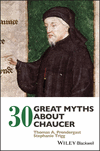THE CANTERBURY PILGRIMS ARE BASED ON REAL PEOPLE
Summary
Chaucer's collection of tales told on the pilgrimage to Canterbury is rightly famous as a compelling snapshot of fourteenth-century life that somehow also seems to transcend its historical setting. J.M. Manly rejects the idea that the Canterbury pilgrims represent all walks of life, and emphasizes the seemingly random selection of crafts and trades represented in the General Prologue. Having relieved Chaucer of the burden of comprehensive representation and argued that Chaucer was writing with close reference to a small community, Manly examines the hints provided by proper names and evidential traces in Chaucer's text that might support some historical identifications. The debate about the realism of the General Prologue took a radically different form after the publication in 1973 of Jill Mann's Chaucer and Medieval Estates Satire.



